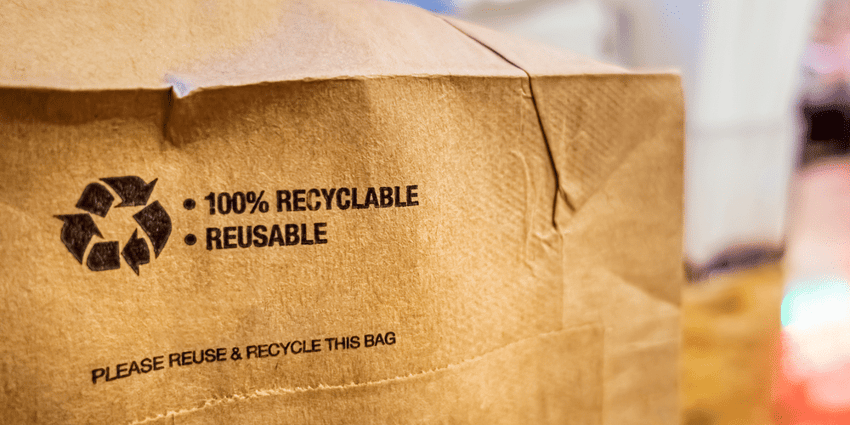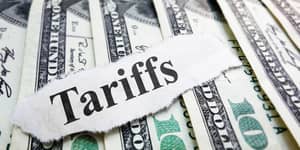Sustainable packaging continues to be a high priority for both consumers and brands.
Australia Post’s 2023 Inside Australian Online Shopping report revealed that three in every four shoppers opt for sustainable options. The biggest consideration is packaging, with 58% preferring recyclable materials.
Using eco-friendly packaging alternatives is no longer an option for ecommerce businesses. It's a necessity.
While there's still quite a way to go in the war on plastic, material science, and package engineering have taken great leaps at developing eco-friendly alternatives. But the real challenge is getting retailers to switch to these materials.
In this article, we’ll explore some of these alternatives and break down the pros and cons. You’ll even get expert tips on implementing them into your business and discover retailers already using them today.
Let’s get started!
What is Sustainable Packaging?
Eco-friendly packaging refers to materials that progressively lessen their environmental impact over time. This can be achieved through various means:
- Ingredients: Utilising 100% recycled or raw materials with minimal environmental impact.
- Production Process: Streamlining production processes and supply chains to reduce carbon footprints.
- Reusability: Establishing a circular economy for the packaging, extending its life cycle and usability.
While it might seem straightforward to associate eco-packaging solely with environmental concerns, it is imperative to consider economic and social factors.
For example, opting for plant-based packaging may unintentionally contribute to deforestation when clearing land for crop cultivation. So it’s worth conducting thorough research on a packaging brand that highlights their eco-friendliness.
Why is Sustainable Packaging Important?
Choosing eco-friendly packaging has a significant impact on the environment. From reducing waste to decreasing the lifespan in landfills, it's a good reason to make the switch.
But there are several other advantages to your business and your customers. These are just a few.
Reduction in Your Carbon Footprint
Traditional packaging production is notorious for its high energy consumption and greenhouse gas emissions. Opting for eco-friendly materials, particularly those derived from recycled materials, requires less energy than packaging production from raw materials.
Non-biodegradable materials like plastic and styrofoam contribute to water pollution and landfill accumulation. Hence, there is an urgency to embrace sustainable packaging options.
Improved Brand Image and Sales
Your packaging serves as the first introduction your customers have to your products. Using eco-friendly materials demonstrates a commitment to sustainability. It’s a belief that resonates with shoppers, particularly millennials and Gen Alpha.
Aligning your brand with eco-friendly values enhances your image and positions you favourably to attract environmentally-aware customers. It’s vital in an era where such considerations significantly influence buying choices.
Waste Reduction Initiatives
As environmental awareness grows, many ecommerce businesses are actively reducing packaging waste by opting for recyclable or reusable materials. Globally, over two billion tons of litter end up in landfills annually. A staggering 91% of packaging waste contributes to this figure.
Many states in Australia have introduced regulations on single-use plastics and shopping bags, emphasising the need for greater recycling practices. Instead of adding more packaging waste to landfills, more ecommerce business owners should switch to compostable or recyclable packaging.
10 Eco-Friendly Packaging Materials You Can Use
There are many different eco-friendly packaging materials available on the market. Here are just some worth investigating further.
1. Biodegradable Packaging Peanuts
Created using renewable resources like corn starch, biodegradable packing peanuts naturally break down in the environment. These are great for filling empty spaces in boxes so your products don’t move around while out for delivery. They also protect multi-item orders from bumping into one another.
Pros of Biodegradable Packing Peanuts:
- Many biodegradable packing peanuts are compostable. They transform into nutrient-rich soil food.
- They dissolve in water, making them a convenient choice for environmentally conscious disposal.
- Their lightweight nature makes them easy to use and keeps shipping costs down.
- Biodegradable packing peanuts protect a wide range of products, from delicate items to heavy machinery.
Cons of Biodegradable Packing Peanuts:
- Exposure to moisture can leave biodegradable packing peanuts soft and mushy. This reduces its ability to protect items.
- They can break during shipping and aren’t ideal for packages going on long journeys.
2. Corrugated Bubble Wrap
A packaging material crafted from corrugated paper and featuring a lining of bubble wrap. This lightweight and robust material is a perfect choice for fragile items.
Pros of Corrugated Bubble Wrap:
- Corrugated bubble wrap is highly effective in shielding various products, particularly delicate items. The air bubbles offer cushioning to guard against shocks and vibrations.
- Due to its flexibility, it’s easy to store and takes up little room.
- It can protect everything from small items to larger appliances.
Cons of Corrugated Bubble Wrap:
- It may not be suitable for some heavier items. The air bubbles can compress, impacting their protective capabilities.
- The material is prone to static, which can attract dust and dirt during use.
- Exposure to moisture can impact the corrugated paper and affect its ability to protect products.
3. Air Pillows Made from Recycled Content
Recycled air pillows utilise post-consumer or post-industrial materials. It helps reduce the environmental impact associated with plastic production and contributes to the circular economy. You can use them to fill voids in your boxes or if you want to stop a product from moving around during the delivery.
Pros of Recycled Content Air Pillows:
- Recycled air pillows contribute to reducing environmental harm linked with plastic manufacturing.
- It also aligns with sustainability goals by participating in a circular economy.
- They ensure reliable cushioning and shock absorption for delicate items throughout shipping.
- Air pillows can protect items such as small electronics and sizable furniture.
Cons of Recycled Content Air Pillows:
- The percentage of recycled content in air pillows can vary among manufacturers.
- Not suitable for heavy items as they may deflate.
- You can’t use them with products featuring sharp edges.
4. Recycled Cardboard and Paper
Using recycled cardboard and paper is one of the most sustainable choices for your ecommerce business. It limits the demand for trees, reduces deforestation and mitigates other environmental impacts. Recycled cardboard boxes come in various sizes, and you can find recycled paper options for lining and filling.
Pros of Recycled Cardboard and Paper:
- Recycled cardboard and paper are crucial in preserving natural resources, particularly trees.
- The production of recycled cardboard and paper generally demands less energy than other packaging materials.
- The versatility of recycled cardboard and paper extends across various packaging, printing and construction purposes.
Cons of Recycled Cardboard and Paper
- The quality of recycled cardboard and paper may fluctuate based on the type and source of the waste paper used. It can impact attributes such as strength, durability and appearance.
- Trace impurities or contaminants from the original materials may be present in recycled cardboard and paper, impacting their suitability for specific products.
- In some cases, recycled cardboard and paper may have slightly lower strength than other materials.
5. Cornstarch Packaging
Cornstarch packaging is crafted from renewable sources such as corn or wheat starch. It presents several advantages, including biodegradability, compostability and water solubility. You’ll mostly find this material used for satchels and padded mailers.
Pros of Cornstarch Packaging:
- Cornstarch packaging naturally breaks down in the environment, reducing the strain on landfills.
- Many cornstarch packaging products are compostable, transforming into nutrient-rich soil food instead of accumulating as waste.
- Cornstarch packaging dissolves in water, making it easy to dispose of.
Cons of Cornstarch Packaging:
- As it dissolves in water, cornstarch packaging can become soft and soggy when exposed to moisture.
- Cornstarch packaging may not be as durable as traditional plastic packaging.
- It might be less readily available in specific sizes or formats.
6. Mushroom Packaging
Mushroom packaging is derived from its roots, a sustainable and biodegradable departure from traditional materials. It’s a lightweight, sturdy, and adaptable material. It is used for boxes and protective linings for inside your parcels.
Pros of Mushroom Packaging:
- Mushroom packaging naturally decomposes in the environment.
- Grown using agricultural waste products it minimises environmental impact.
- It is a moldable material that can be formed into various shapes and sizes.
Cons of Mushroom Packaging:
- It might require controlled storage conditions to preserve its integrity.
- Some mushroom packaging could be more expensive than traditional materials due to its specialised production process.
- It may not offer the same level of barrier protection due to its moldable materials.
7. Seaweed Packaging
Seaweed-based packaging is crafted from extracted and processed fibres. It boasts several promising features, including biodegradability and compostability. There are boxes and protective linings made from this material.
Pros of Seaweed-Based Packaging:
- It naturally decomposes in the environment, reducing the impacts on landfills.
- Seaweed is a renewable resource that can be cultivated in marine environments without affecting land resources.
- Seaweed-based packaging is an adequate barrier protection from moisture, gases and odours.
Cons of Seaweed-Based Packaging:
- Still in the developmental stage, seaweed-based packaging may be harder to locate than traditional packaging materials.
- It can also be more expensive due to the manual processing.
8. Biodegradable Plastics
Biodegradable plastics are designed to naturally break down into byproducts like water, carbon dioxide and methane. Using renewable sources, such as plant-based materials (e.g., corn starch or sugarcane), they are considered a more environmentally friendly alternative to traditional options. They are also used in multiple products for shipping. You can find inner lining bags, packing peanuts, and even padded satchels made from them.
Advantages of Biodegradable Plastics:
- Many biodegradable plastics are compostable and can be used in gardens.
- The production of biodegradable plastics typically results in lower greenhouse gas emissions compared to traditional plastics.
- Biodegradable plastics are more versatile than other materials and can be used for multiple products.
Cons of Biodegradable Plastics:
- The biodegradability rate for these plastics can fluctuate based on material composition, environmental conditions and disposal methods.
- Some biodegradable plastics may break down into microplastics, raising environmental concerns.
9. Organic Ecological Textiles
Organic textiles utilise fabrics crafted from organic fibres. They’re cultivated and processed without synthetic pesticides, herbicides or fertilisers. They are produced using sustainable manufacturing practices to minimise their environmental footprint. You can use these as a protective bag for your products as they travel to their destination.
Pros of Organic Ecological Textiles:
- Produced with methods less detrimental to the environment, organic ecological textiles reduce soil and water pollution.
- Organic ecological textiles are less likely to contain harmful chemicals or allergens.
- Purchasing these materials can encourage sustainable agriculture practices and promote the growth of the organic textile industry.
Cons of Organic Ecological Textiles:
- The relatively small organic textile industry may result in a more restricted availability of materials compared to traditional options.
- Some items may demand more careful maintenance due to their natural fibre composition.
- You might experience faster colour fading as they lack the dye treatments.
10. Recycled Plastics
These materials are extracted from drums, pallets and other everyday consumer and industrial items. While there is a limit on how many times these products can be used, it gives them another use and delays them from ending up in landfills instantly. Multiple products are available using this material, such as bag linings and padded satchels.
Pros of Recycled Plastics:
- The recycling process of plastics helps reduce air and water pollution associated with production and disposal.
- Recycling plastics provides the original materials with alternate uses instead of going directly to landfills.
Cons of Recycled Plastics:
- Trace amounts of contaminants from the original materials may be present in recycled plastics, affecting their suitability for specific products.
- Some recycled plastics may undergo downcycling, resulting in the production of lower-quality products compared to the original plastic material.
- It may sometimes require more energy than producing new plastic from original materials.
How to Introduce Sustainable Packaging to Your Business
Ready to make the switch to eco-friendly solutions? It can take time to implement this change successfully. Use these expert tips to make it easier for you and your customers.
Avoid Changing Everything at Once
You might be tempted to switch to sustainability packaging instantly. However, taking this approach can lead to more harm than good.
Introducing new materials involves thorough research and testing. Instead of replacing all your supplies with greener alternatives at once, start with one or two items. For example, if your boxes come in multiple sizes, switch just one of them to gauge its effectiveness. If the outcomes are positive, you can proceed to larger options.
Sample and Test Multiple Products
Several companies offer eco-friendly packaging solutions. To find the one that suits your needs, request some samples. If the vendor provides them for free, that's great. Otherwise, consider placing a small order to evaluate their items. Some of the factors you will want to consider are:
- Ensure that the packaging materials complement your products. Place your items inside and assess their fit. Is it easy for customers to unbox items? These questions are crucial when evaluating options.
- Put the packaging through a stress test. Place your products inside and simulate the conditions they might encounter during typical shipping. If possible, bend the material, apply pressure, or even toss it around to assess how well it protects the contents.
- Choose packaging with suitable dimensions and weight. It should be large and sturdy enough to contain your products but not overly excessive that it affects the delivery costs.
Adjust Your Pricing
The type of packaging you choose may result in higher material and shipping costs. Account for this when setting your prices. If you plan to absorb the additional costs, perform the necessary calculations to maintain your profit margins.
Order in Small Volumes
Order small volumes of packaging materials to assess factors such as durability, customer reception, and overall performance compared to your previous packaging. Gradually increase your orders as you feel more comfortable with the materials.
Listen to Your Customers
Remember that your customers want eco-friendly packaging. Ask them what they desire so you understand their concerns and preferences. Are they critical of your current packaging practices? Can they suggest alternative solutions? To what extent are they willing to pay more for environmentally friendly options? Identify which packaging features they would compromise on, such as aesthetics or design elements.
When you have your answers, establish your environmental goals by weighing the feedback against the operational needs of your business. For example, ensuring adequate protection during transportation.
Current Business Using Sustainable Packaging Materials
Many ecommerce businesses have already started shipping their products using sustainable packaging materials. Here are just a few examples.
Adorn Cosmetics
Specialising in natural and organic skincare and makeup products, Adorn Cosmetics integrates eco-friendly alternatives across its entire supply chain.
They utilise multiple sustainable packaging materials, such as recycled cardboard and biodegradable packing peanuts. They also provide refill options for many products to reduce waste and promote circularity. Since the program's inception, it has prevented over 145,000 plastic items from ending in landfills.
Paire
Not only does Paire strongly emphasise eco-friendly packaging solutions, but some of its products are made from sustainably harvested beech trees. They use less energy and water than cotton.
They are also transparent regarding their packaging materials and encourage customers to recycle or compost them responsibly. They even take proactive steps to educate shoppers about the environmental impact of their materials and packaging options.
Clea
This clothing brand showcases timeless and ethically produced fashion. Clea is committed to sustainable packaging materials and strives to minimise waste at every opportunity.
Clea actively engages with its customers to raise awareness about sustainable packaging practices and promotes responsible recycling and composting habits.
Spell
Spell maintains a transparent commitment to reducing its carbon footprint. They even advertise their roadmap on the website. The ecommerce store’s products are dispatched in 100% biodegradable poly bags that naturally break down over time.
To add an extra layer, the garments are carefully packed into reusable organic eco-tote bags made from organic cotton.
Why Now Is the Time to Make the Switch
Sustainability is important because it shows your brand's commitment to caring for our environment. Fighting climate change puts us all on the front line, so approaching and applying actions to combat it through small businesses is vital. It also shows the thought and care you have put into your brand and your company's commitment to providing customers with quality products. There are lots of ways to start being more sustainable with your packaging. Whether it's opting for biodegradable materials or choosing something more experimental like mushrooms or seaweed, you're paving the way to a more sustainable future for everyone.
 Are you affected by the Sendle service suspension? We have an immediate shipping solution for you!
Are you affected by the Sendle service suspension? We have an immediate shipping solution for you!










 Facebook
Facebook Twitter
Twitter Instagram
Instagram Linked In
Linked In YouTube
YouTube